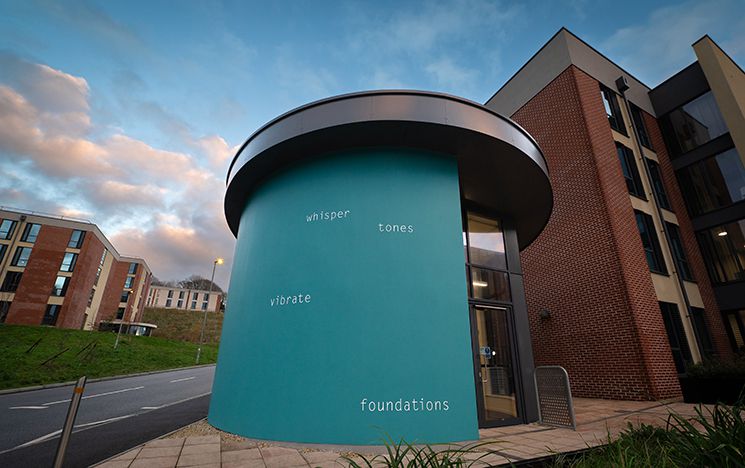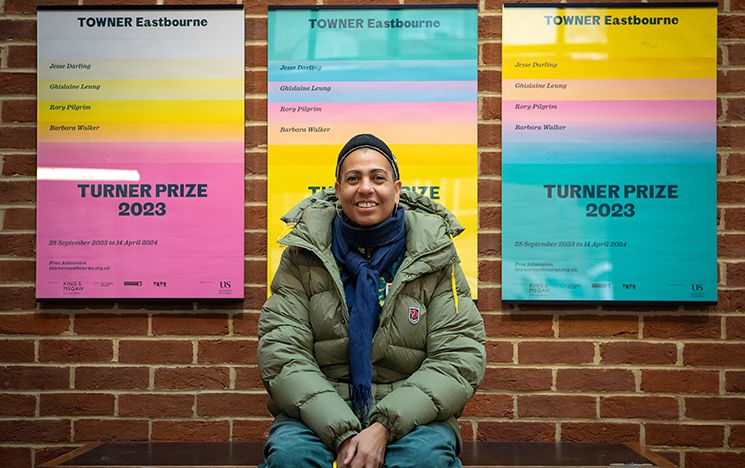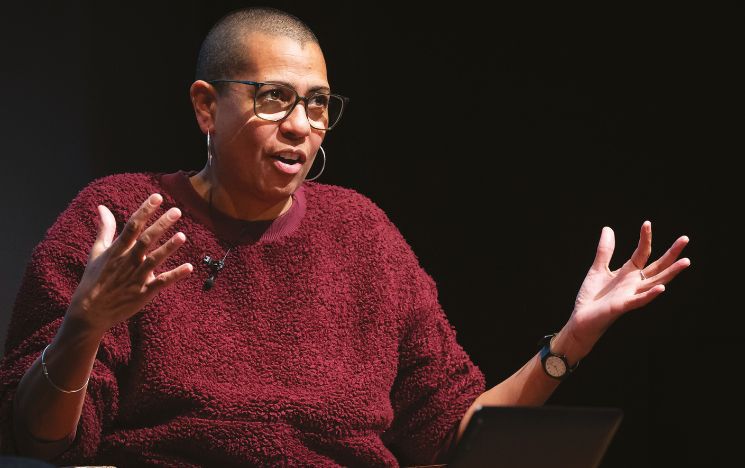The art of articulation
Turner Prize-winner Helen Cammock (Sociology BA Hons, 1989) reflects on her profound and complex relationship with words and her path to artistic self-discovery.
In 2019, Helen Cammock became a joint winner of the prestigious Turner Prize after all four nominees made a plea to the judges to jointly receive the award in the interest of “commonality, multiplicity and solidarity”.
Subverting the rules meant the £40,000 prize money was split equally between the artists – and almost everyone was happy. “We aggravated many people, but received so many messages from artists saying, ‘finally someone has said we don’t have to compete like athletes’,” she says.
For Helen, the exposure opened conversations and led to prestigious commissions, including The London Tube Map cover and text posters across London Underground stations where travellers at the end of Covid times were invited to 'sit alongside and feel me breathe'. “It wasn’t about sharing a virus, but thinking about empathy and care,” she says.
As a 'visual poet’, Helen juxtaposes words and images through photographs, film, print and drawings. She is interested in narratives around Blackness, oppression, poverty and vulnerability, with her works often involving marginal voices.
Helen earned her Turner Prize nomination with a film about the role of women in Northern Ireland’s Civil Rights Movement. In 2022, she was invited by Serpentine Galleries to work with Pause (a London-based charity for women who have had children removed from their care) to explore ideas of resistance and resilience and how they manifest in the body and voice. The work became Radio Ballads, which included a performance of a song composed by Helen.
A year later, she was commissioned by Sussex to produce a piece for campus. The words whisper tones vibrate foundations now adorn an external curved wall of the Student Centre. “I was contemplating this project for a long time – the importance of ideas, thinking and learning – and the freedom that should be enabled with all of those things,” she says. “I value this idea of foundation in a university. New ideas will always whisper in those foundations, but they will also need the contribution of earlier thinking to learn and develop.”

She is fascinated by the power of words and how their meanings can be “engaged with differently” depending on how they are presented and by whom. “It has taken me a long time to understand what I am trying to do,” she says. “I think it started because, although I am good at spelling and have no problem writing, I have always found it difficult to take in information when I’m reading.” Growing up, Helen relied on her sister – a prolific reader – to retell stories and texts in ways that Helen could absorb. “I’ve spent a lot of time reading through my sister’s eyes.”
Helen didn’t discover her creative side until her 30s. Even though her Jamaican father was an art teacher, it wasn’t a subject that appealed to her at school. “I was good at sport. It felt like a space in which I could be myself. Art didn’t do that,” she says. “I remember doing a ceramics class and the teacher put me on the ‘remedial’ table because I didn’t want to make a cup with a round handle.”
As a teenager “who always had to fight for a cause and everything was a debate”, Sussex seemed a natural choice. She was drawn to its “radical histories” and “gentle energy”.
“It’s something about the space, the buildings and light, and that it’s out of town,” she says. “All of those things attracted me. I had just started a relationship with my first girlfriend, and I felt that in Brighton I was coming to a space that was safe.”
I began to understand the transformative power of art and realised it was something I needed to be a part of.”
After university, she became a council playworker, then a social worker in Brighton – often working with families and children. One project involved those who had experienced, and perpetrated, domestic violence. “I learned that nothing was ever as clear as it seemed and that humans respond to structural and emotional abuse in myriad ways.”
Ten years later, with funding cuts causing more children to go into social care and families to struggle, she left her job. “I didn’t want to be part of a system that claims it’s a support system yet actually isn’t.”
She began a BA in photography at the University of Brighton alongside running a multiagency support service for young people. In her second year, she landed a prestigious internship with Photoworks journal, and on graduating took over the co-running of Brighton Photo Fringe’s festival and activities. The year she exhibited her own work, she was invited to apply for a Masters at the Royal College of Art.
Public art institutions and artists have become more interested in art that’s attempting to change the way we see, think, feel and hear.”
“I wondered if being an artist was a bit self-indulgent and selfish,” she says, “but the landscape of art is continually changing. Public art institutions and artists have become more interested in art that’s attempting to change the way we see, think, feel and hear. I began to understand the transformative power of art and realised it was something I needed to be a part of.”
At present, Helen lives in Wales and, with the support of the Paul Hamlyn Foundation, has found the headspace to consider new projects. These include a film about love and care – and the lack of it – which is planned to be made with her partner, film producer Laura Shacham. “We have different heritages and there is something interesting for me in trying to twine together diverse, and perhaps conflicting, stories,” she says. “It is our story, but one that is also widely shared. It shapes who we are and how we have come to be.”

